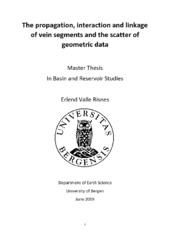The propagation, interaction and linkage of vein segments and the scatter of geometric data
Master thesis
Permanent lenke
https://hdl.handle.net/1956/20490Utgivelsesdato
2019-06-28Metadata
Vis full innførselSamlinger
- Master theses [106]
Sammendrag
The lengths, widths, orientations, bridge widths and linkage characteristics of 636 vein segments from 84 arrays have been measured and analysed. The relationships between the parameters are assessed. The veins are in the Blue Lias Formation exposed on the Somerset coast, UK. E-W orientated arrays (mostly related to basin extension) are compared with N-S orientated arrays (related to later basin contraction). The parameters measured mostly show weak correlations coefficients. Scatter in the data result both from the way vein segments propagate, interact and link and from the way measurements were made. Veins appear to propagate in three stage cycles. Stage 1: propagation, with length and width increasing proportionally. Stage 2: interaction, where a segment interacts with one or more adjacent segments, so propagation is hindered but dilation continues. Stage 3: linkage, where adjacent segments connect to form a composite segment, so length increases but maximum width does not change. These stages can be repeated for the composite segment, creating a cycle of development and segmentation across a range of scales. A steplike trajectory occurs on a plot of vein length to width. The segmentation across a range of scales means that the definition of segments can be subjective, with the number of vein segments defined being controlled by resolution. In this study, linkage was characterised in terms of topology, i.e. if a segment is not connected in the plane of view, or whether it is connected at one or both ends of the trace. This may not have been the best way to characterise the segmentation of interacting and linked vein segments.
